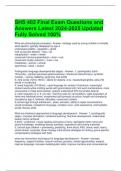SHS 402 Final Exam Questions and
Answers Latest 2024-2025 Updated
Fully Solved 100%
What are phonological processes - Answer- strategy used by young children to simplify
adult speech, typically disappear by age 4
unstressed syllable - spaghetti = ghetti
final consonant deletion - dog = do
reduplication - water = wawa
consonant harmony/assimilation - duck = kuk
consonant cluster reduction - truck = tuk
metathesis - animal = aminal
epenthesis - black = bulack
Prelinguistic language developmental stages - Answer- 1.) prelinguistic (birth -
12months) - partner perceived (perlocutionary), intentional (illocutionary), symbolic
(verbal)... cooing, babbling, jargoning, first words
2.) first words (12mo-18mo) - labels for objects, cvcv, nasals/stops/glides, about 50
words in vocabulary
3.) early linguistic (18-30mo) - uses language for variety of intentions, meaningful
content words while omitting words with grammatical info, first word combinations, more
consonants in initial word position, speech understood 50% by familiar listener
4.) later linguistic (3, 4, 5, yrs old) - learning rules for conversation, rapid acquisition of
items and relational terms, morphemes and syntactic structure, length and complexity
increase by age 4, fricitives, affricates, consonant clusters
5.)school age through adolescent - jokes, sarcasm, ability to repair conversations,
vocab increases, metaphoric language, complex noun, verb expansions, multi syllabic
words, literacy skills
What are treatment approaches to language development - Answer- 1.) prelinguistic
stage = focused stimulation, incidental teaching, floortime development, relationship
based, family centered
2.)birth - preschool = book reading and sense of story, alphabetic letter name and
sound knowledge, modeling literacy activities, experience with writing materials
3.) school age children = previewing, predicting, think aloud, KWL (know, want, learn),
social stories, computer driven therapy instructional strategies for writing, genre specific,
compensatory strategies with AAC
what are intervention techniques for language development - Answer- increase
frequency, support families, natural routines, practice, create opportunities, expand,
improve language, increase metalinguistic skills, improve narrative and conversational
, discourse, work with teachers, provide individual and group therapy, use functional
activities
what are metalinguistic skills - Answer- nonliteral and figurative use of language
language intervention strategies - Answer- *create opportunities - sabotage, violate,
routine, withhold objects/turns, violate object function, hide objects, scripted play
*interactive modeling - focused stimulation (self-talk - parallel talk - event casts),
modeling with expansion, modeling with recast, vertical structuring, scaffolding
*milieu teaching - model, mand-model, time delay, incidental teaching
second language acquisition development - Answer- simultaneous or sequential
patterns of second language acquisition - Answer- -Interference or transfer: aspect of L1
generalize to L2 (dialect/phonological or words/semantic influence)
-Interlanguage: occurs when a speaker develops a personal linguistic system while
attempting to produce the target language.
-Silent period: don't speak much of L2 - more observational learning.
-Code Switching: easily alternates between 2 languages.
-Language loss: decline in L1 while L2 is being learned.
core behaviors in stuttering - Answer- repetitions, prolongations, blocks, dysfluencies
primarily on first sound
secondary behaviors of stuttering - Answer- escape behavior - head nods, eye blinks,
jaw tremors
avoidance behavior - substitutions, tension, pauses
attitudes and emotions
fluency shaping techniques involved in stuttering - Answer- goal is to increase fluent
speech, teach client techniques to produce fluent speech, gradually shape to sound as
normal as possible.
~ easy onsets - start voicing on exhalation
~decrease speaking rate
~light articulation contacts
~continuous phonation
~change your overall speech pattern
~delayed auditory feedback
what are stuttering modification techniques - Answer- modify stuttering to make
episodes acceptable, focus on the moment of stuttering
~identification
~desensitization
~relaxation
~in block corrections/pull-outs
~post block corrections - cancellations




